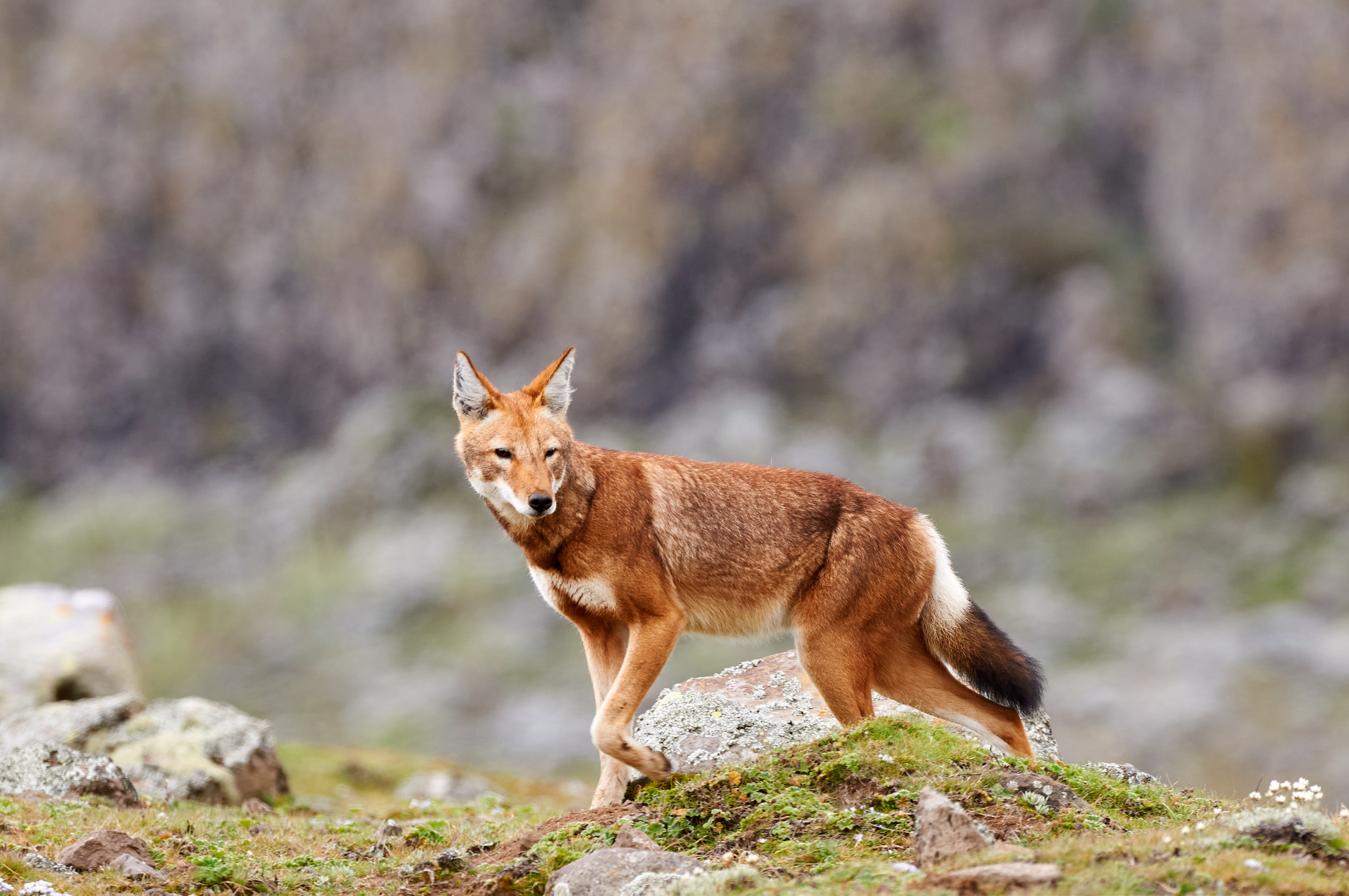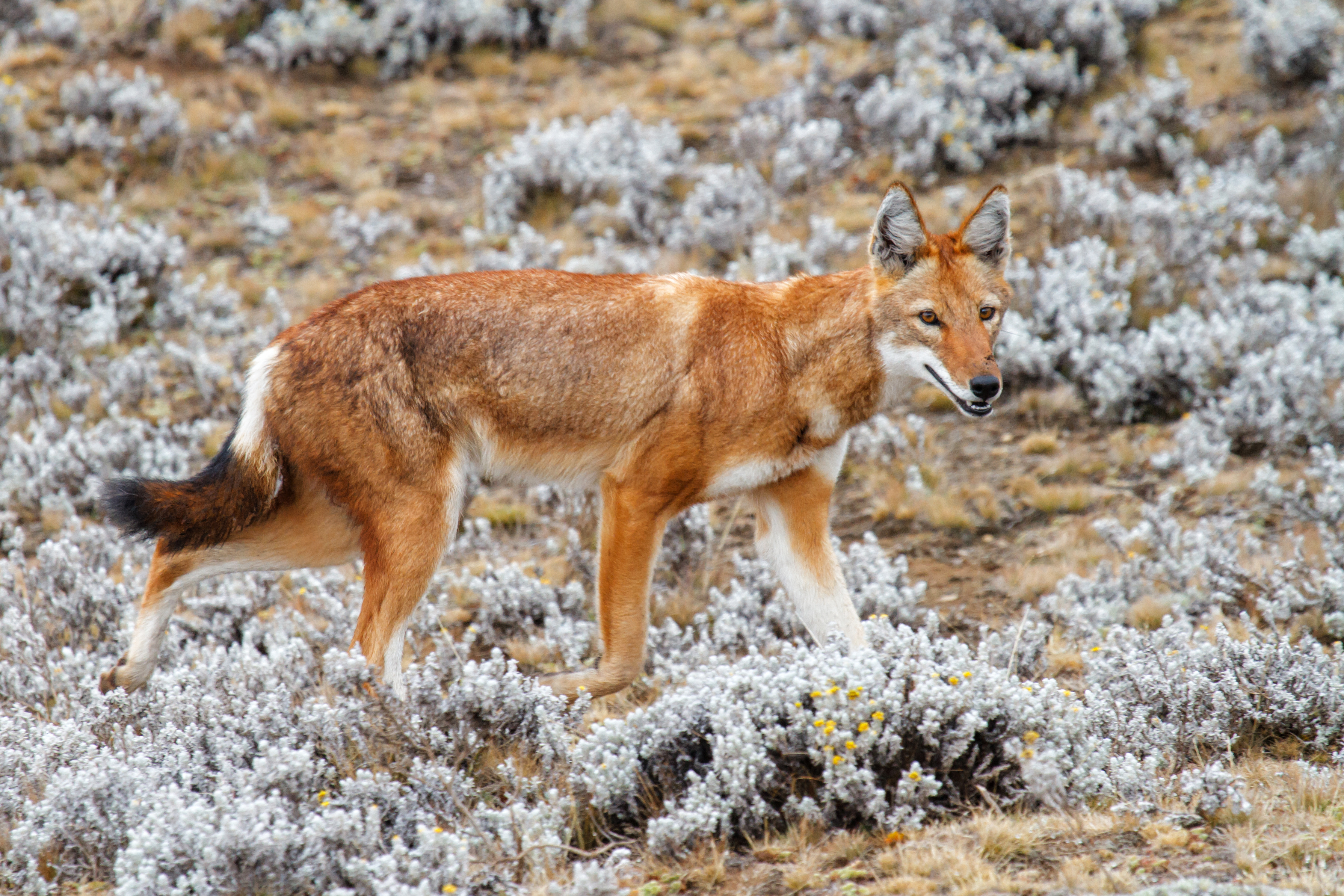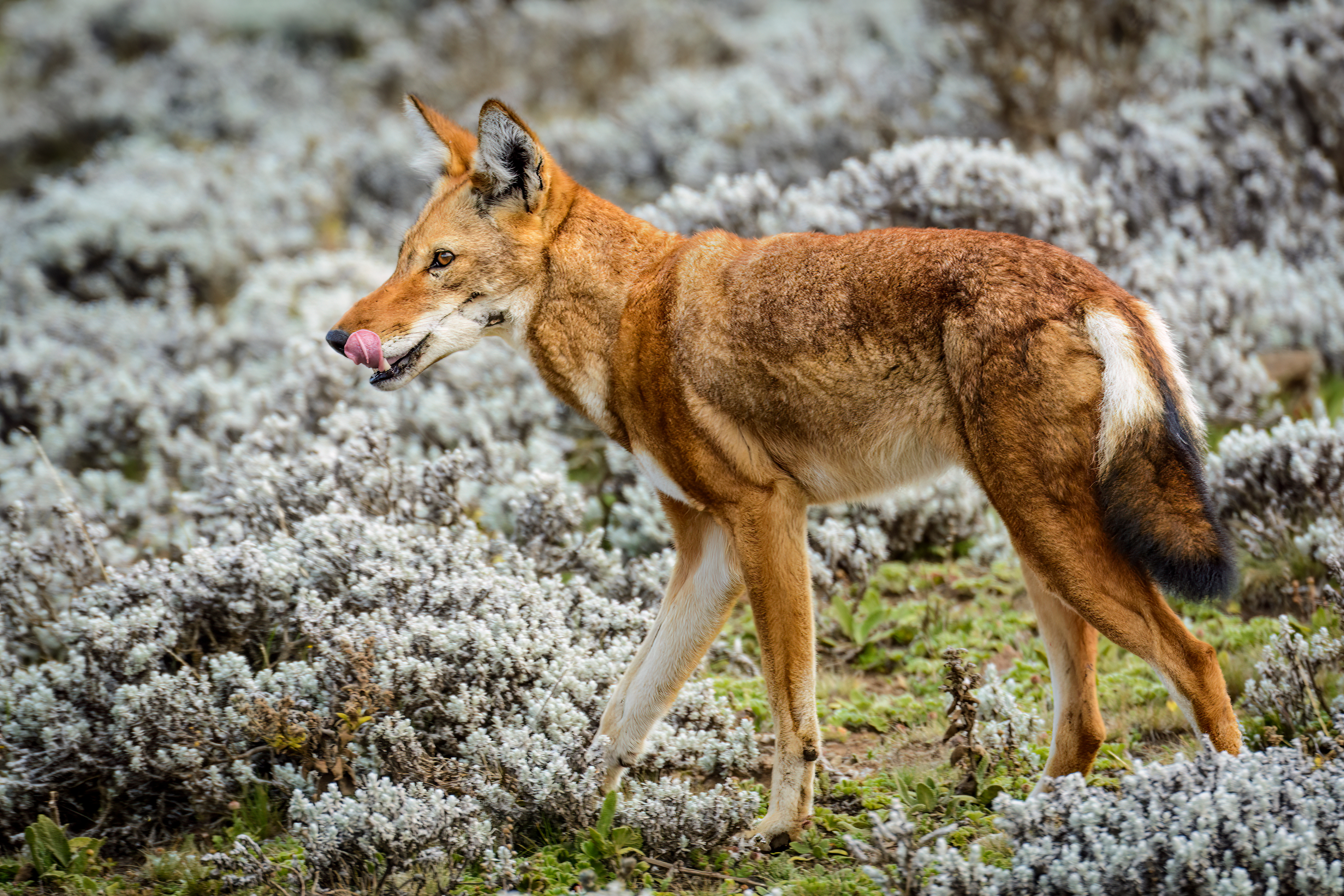Protecting the Ethiopian Wolf: A Conversation with Tibebu Yelemfrhat Simegn

The Ethiopian wolf (Canis simensis), an endangered canid that lives on the Ethiopian Highlands.
Tibebu Yelemfrhat Simegn’s journey into conservation was born from a boyhood spent in the heart of Ethiopia’s Afroalpine highlands. As a young shepherd, he often encountered the rare and enigmatic Ethiopian wolf, chasing it in the wild without understanding its ecological importance. Decades later, Tibebu is no longer the pursuer, he is the guardian. Now serving as Landscape Manager for AWF in Ethiopia, he works tirelessly to protect the species that once fascinated him as a child. The Ethiopian wolf is the most endangered carnivore in Africa and the rarest wolf species in the world. Found only in the high-altitude ecosystems of Ethiopia, it plays a crucial role in maintaining the health of fragile Afroalpine ecosystems. On International Wolf Day, Tibebu reflects on the species’ status, the conservation interventions led by AWF, and what must happen next to secure its survival.
Q: Why does International Wolf Day matter for Ethiopia, and what makes the Ethiopian wolf such a critical species to conserve?
Tibebu: International Wolf Day is an important moment to elevate awareness around the global and local importance of wolves, but for Ethiopia, it’s also an opportunity to draw attention to a species that exists nowhere else on Earth. We have between 450 and 500 adult Ethiopian wolves left, surviving in isolated patches of Afroalpine habitat, places like Simien Mountains National Park, Bale Mountains National Park, Arsi Mountains, Borena-Sayint, Guassa, and Abune Yoseph. This species is more than a symbol of our natural heritage, it is a keystone predator whose survival ensures the ecological balance of these unique highland systems. By preying on moorland rodents, particularly grass rats, the Ethiopian wolf helps control populations that would otherwise degrade highland vegetation. Its presence safeguards biodiversity, supports rangeland management, and even contributes to climate resilience, core principles in AWF’s ecosystem-based conservation approach. When people understand that losing the wolf means unraveling the entire highland ecosystem, they begin to value it as a vital part of our environmental future.
Q: What are the current threats to the Ethiopian wolf, and how are they evolving across the different landscapes where it survives?
Tibebu: Threat levels vary from one site to another, but across the board, the most pressing challenges are habitat loss, human–wildlife conflict (HWC), and disease. Nearly all areas where Ethiopian wolves live are inhabited by semi-pastoralist communities, and competition for natural resources is increasing. Shrinking habitats bring wolves and livestock into closer contact, often sparking conflict. In response, we’re implementing grazing strategy approaches that limit livestock movement in the core wolf ranges. We’ve introduced resource use agreements and regularly convene local dialogue forums, like the Guassa Conference, where community members and local leaders come together to identify and address tensions. These platforms give voice to local experiences and create opportunities for consensus-driven solutions. The result is greater community ownership of conservation efforts, which is essential for long-term success. We also support alternative livelihood projects, which help communities derive benefits from conservation rather than seeing wildlife as a threat. The aim is to strike a balance between protecting endangered species and sustaining human development.

Ethiopian wolf walking on the Sanetti Plateau in the Bale Mountains in Ethiopia.
Q: How has disease impacted Ethiopian wolf populations in recent years, particularly in Bale Mountains where rabies and canine distemper were once a major concern?
Tibebu: Since 2008, the Bale Mountains population alone declined by about 30 percent due to rabies and canine distemper. However, more recently, disease outbreaks have become less frequent. While AWF has not been directly involved in vaccination efforts since 2018, mainly due to access restrictions and shifts in programming, we recognize the valuable role that partners like the Ethiopian Wolf Conservation Programme (EWCP) have played in this area. EWCP-led vaccination drives for domestic dogs have significantly reduced disease transmission risk to wild wolves. Although we are not currently funding these efforts directly, we are committed to sharing updates and staying aligned with EWCP's work. The general consensus is that while disease remains a latent threat, it has not been a primary cause of recent wolf declines.
Q: What steps has AWF taken to protect Ethiopian wolf habitat, especially in places like the Simien Mountains?
Tibebu: In partnership with the Ethiopian Wildlife Conservation Authority (EWCA), AWF has made substantial progress in Simien Mountains National Park. We’ve focused on grazing pressure reduction, habitat rehabilitation, community education, and law enforcement support. As a result, habitat conditions in the Simien are currently in a stable state. One of our key strategies has been to embed conservation into local development, creating linkages between environmental protection and community well-being. This includes support for water management, sustainable land use, and initiatives like Classroom Africa, which integrates conservation education into local schools.
Q: How do community-based initiatives like Wolf Ambassadors and cash-for-work programs contribute to the broader conservation strategy?
Tibebu: While AWF no longer directly funds the Wolf Ambassador program under EWCP, we continue to support these community leaders in indirect ways, such as providing logistical assistance and linking their work to larger development programs. These ambassadors are incredibly committed individuals, often driven by passion and a deep understanding of the local landscape. They help monitor wolves, report threats, and serve as trusted conservation advocates. Our cash-for-work projects, launched during the COVID-19 pandemic, offered temporary employment for vulnerable households while contributing to habitat restoration and infrastructure improvement. These efforts not only alleviated economic hardship but also deepened awareness of how protecting the wolf can deliver real livelihood benefits. It’s about making conservation a shared responsibility and a shared reward.
Q: What are some recent success stories in wolf conservation, and what challenges remain?
Tibebu: One of the most encouraging signs is the consistent sighting of pups in nearly every wolf pack in Simien in recent years. Despite the challenges of political instability and logistical constraints, our ranger-based monitoring and community reporting systems have confirmed that the population is relatively stable. However, working in these remote and sometimes insecure areas has not been easy. Over the past four years, the conservation team has had to adapt by relying more on local informants and grassroots data collection. We’ve also had to contend with declines in other key species like the Walia ibex, which adds complexity to ecosystem management. What we’ve learned is that adaptive management and local partnerships are critical. When government, communities, and conservationists collaborate, even the toughest challenges become manageable

Ethiopian wolf also known as Abyssinian wolf, Simien wolf, Simien jackal, Ethiopian jackal, red fox, red jackal.
Q: What are AWF’s next steps to ensure the Ethiopian wolf’s survival?
Tibebu: Moving forward, our priorities include expanding habitat protection, strengthening community-led monitoring, and increasing disease prevention measures. Habitat corridors between isolated wolf populations are essential for genetic diversity and reducing the risk of local extinctions. We will continue working with partners to enhance domestic dog vaccination programs in surrounding communities, which prevent the spread of rabies and canine distemper. Education and awareness, especially among young people, will remain a cornerstone of our work, ensuring that the next generation values and safeguards the Ethiopian wolf. Our long-term vision is to integrate wolf conservation into broader landscape-level conservation plans so that protecting this species also strengthens livelihoods, safeguards biodiversity, and builds resilience for both people and nature in Ethiopia’s highlands.
Q: Finally, on a personal note, what inspired you to dedicate your career to the Ethiopian wolf, and what motivates you to keep going?
Tibebu: My connection to this species began in childhood. I was a shepherd, and the Ethiopian wolf was part of my daily life. At that time, I didn’t fully grasp its ecological importance. Today, I see it as an apex predator that holds the highland ecosystem together. It’s not just a tourist attraction. It is an indicator species, its sensitivity to environmental changes tells us a lot about the health of these mountains. The wolf controls the population of moorland rodents, which in turn protects grasslands from degradation. If we lose the wolf, we risk losing the entire ecosystem. But more than that, we risk losing a symbol of balance, resilience, and ecological harmony. People often don’t understand this vital role. That’s why we must invest more in advocacy and public awareness. Donors, governments, and citizens alike need to recognize the Ethiopian wolf as a flagship species for climate adaptation, biodiversity, and community-centered conservation. That is what drives me.
Q: How can people support the Ethiopian wolf and the work of the African Wildlife Foundation?
Tibebu: Advocacy is essential. Talk about the Ethiopian wolf. Share its story. Help others understand its importance beyond tourism. But equally critical is financial support. AWF’s work depends on donations that allow us to run education programs, restore habitats, and build sustainable conservation partnerships. Responsible tourism also helps, especially when it’s linked to local benefit-sharing. On this International Wolf Day, I encourage readers to support AWF’s Ethiopian wolf conservation efforts, and become ambassadors for a species that needs all the help it can get.